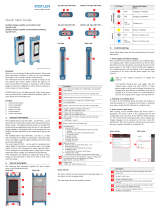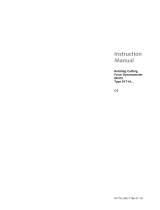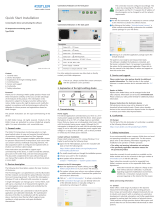Page is loading ...

Instruction
Manual
Piezoelectric Load Cells
Type 9301C … 9371C
9301C_002-994e-09.21


Foreword
9301C_002-994e-09.21 Page 1
Foreword
Thank you for choosing a Kistler quality product
characterized by technical innovation, precision and long
life.
Information in this document is subject to change without
notice. Kistler reserves the right to change or improve its
products and make changes in the content without
obligation to notify any person or organization of such
changes or improvements.
© 2021 Kistler Group. Kistler Group products are protected
by various intellectual property rights. For more details visit
www.kistler.com. The Kistler Group includes Kistler
Holding AG and all its subsidiaries in Europe, Asia, the
Americas and Australia.
Kistler Group
Eulachstraße 22
8408 Winterthur
Switzerland
Tel. +41 52 224 11 11
www.kistler.com

Piezoelectric Load Cells, Type 9301C ... 9371C
Page 2 9301C_002-994e-09.21
Contents
1.Introduction .................................................................................................................................... 3
2.Important Notes ............................................................................................................................. 4
2.1For Your Safety .................................................................................................................... 4
2.2Notes on Handling the Instrument ....................................................................................... 5
2.3Tips on the Use of These Operating Instructions .................................................................. 6
2.4What Happens in the Event of Changes? ............................................................................. 6
2.5Disposal Instructions for Electrical and Electronic Equipment ................................................ 6
2.1Software Upgrades and Updates .......................................................................................... 6
3.General Description of the Instrument Text .................................................................................... 7
3.1What is the Purpose of a piezoelectric load cell? .................................................................. 7
3.2Functional Principle .............................................................................................................. 8
3.3Construction of the Piezoelectric Load Cell ........................................................................... 9
4.Assembly, Installation and Initial Start-up ..................................................................................... 10
4.1Important Notes ................................................................................................................. 10
4.2Installing the piezoelectric load cell ..................................................................................... 10
4.3Standard Wiring and Cabling of the Measuring System ..................................................... 13
4.4Various Mounting Possibilities, Force Introduction ............................................................. 15
5.Operation ..................................................................................................................................... 17
5.1Range Selection .................................................................................................................. 17
5.2Measuring Small Force Changes ......................................................................................... 17
5.3Useful Frequency Range ..................................................................................................... 19
5.4Temperature Influences ...................................................................................................... 20
5.5Polarity of the Measuring Signal ......................................................................................... 20
6.Maintenance ................................................................................................................................ 21
6.1Recalibrating the Instrument .............................................................................................. 21
6.2Maintenance Work ............................................................................................................ 21
7.Rectifying Faults ........................................................................................................................... 22
7.1Troubleshooting ................................................................................................................. 22
7.2Defective load cell .............................................................................................................. 23
8.Technical Data .............................................................................................................................. 24
9.Glossary ........................................................................................................................................ 25
9.1What does this Expression Mean? ...................................................................................... 25
9.2Measurement Uncertainty .................................................................................................. 29
9.3Linearity ............................................................................................................................. 30
9.4Frequency Range ............................................................................................................... 32
9.5Influence of Temperature ................................................................................................... 33
10.Warranty ...................................................................................................................................... 35
Total pages 35

Introduction
9301C_002-994e-09.21 Page 3
1. Introduction
Please take the time to thoroughly read this instruction
manual. It will help you with the installation, maintenance,
and use of this product.
To the extent permitted by law Kistler does not accept any
liability if this instruction manual is not followed or
products other than those listed under Accessories are
used.
Kistler offers a wide range of products for use in measuring
technology:
Piezoelectric sensors for measuring force, torque, strain,
pressure, acceleration, shock, vibration and acoustic-
emission
Strain gage sensor systems for measuring force and
torque
Piezoresistive pressure sensors and transmitters
Signal conditioners, indicators and calibrators
Electronic control and monitoring systems as well as
software for specific measurement applications
Data transmission modules (telemetry)
Kistler also develops and produces measuring solutions for
the application fields engines, vehicles, manufacturing,
plastics and biomechanics sectors.
Our product and application brochures will provide you
with an overview of our product range. Detailed data
sheets are available for almost all products.
If you need additional help beyond what can be found
either on-line or in this manual, please contact Kistler's
extensive support organization.

Piezoelectric Load Cells, Type 9301C ... 9371C
Page 4 9301C_002-994e-09.21
2. Important Notes
It is essential for you to study the following information,
compliance with which is for your personal safety during
the work and will ensure long, fault-free operation of the
instrument.
2.1 For Your Safety
This instrument has been thoroughly tested and has left
the factory in a perfectly safe condition. In order to
maintain this condition and to ensure hazard-free
operation, the user must comply with the information
and warning notes contained in these operating
instructions
The force transducer must be installed, operated and
maintained only by persons who are familiar with the
instrument and are adequately qualified for the work
concerned
If safe operation is no longer assumed to be possible,
the instrument must be disconnected and made safe
against accidental operation
It must be assumed that safe operation is no longer
possible
when the instrument shows visible signs of
damage
when the instrument is no longer operating
after lengthy storage under unsuitable conditions
after very rough transport conditions
Secure the load cell correctly. See details in section 4.2
Installing the piezoelectric load cell.
Secure all parts mounted on the load cell according to
the anticipated forces.

Important Notes
9301C_002-994e-09.21 Page 5
2.2 Notes on Handling the Instrument
The load cell must only be used under specified
environmental and operating conditions
The insulation resistance is of decisive importance in
piezoelectric sensors; it must be approximately 1014 Ω
(but at least 1013 Ω)
In order to obtain this value, all plug connectors must
be kept scrupulously clean and dry
The insulation resistance can be measured with the
insulation tester Type 5493
Protect the instrument connector against contamination
and on no account touch it with your fingers (front of
connector). Fit the cover supplied when the connection
is not in use
The connecting cable (from the force transducer to the
input of the charge amplifier) is highly insulated. Use
only the connecting cable specified
The cable should not be removed from the force
transducer on any occasion after installation
When it is not in use, protect the force link by storing it
in the packing case provided
Ensure that the temperature of the load cell remains as
constant as possible during measurements, especially
when measuring quasistatically, i.e. in DC-mode (Long
Time Constant)

Piezoelectric Load Cells, Type 9301C ... 9371C
Page 6 9301C_002-994e-09.21
2.3 Tips on the Use of These Operating Instructions
We advise you basically to read through the entire
operating instructions. However, if you are in a hurry and
already have experience with Kistler piezoelectric load cells,
you can restrict yourself to the specific information needed.
We have endeavored to give these instructions a neat
layout to make it easy for you to gain direct access to the
information you require. Please keep these instructions in a
safe place where they are always to hand. If you lose these
instructions, please contact your Kistler customer service
organization and you will receive a replacement by return.
All details and directions in these instructions are subject to
change at any time without prior notice.
2.4 What Happens in the Event of Changes?
Equipment modifications will normally result in changes to
the operating instructions. In such cases, please contact
your Kistler customer service organization concerning
updating facilities for your documentation.
2.5 Disposal Instructions for Electrical and Electronic Equipment
Do not discard old electronic instruments in municipal
trash. For disposal at end of life, please return this product
to an authorized local electronic waste disposal service or
contact the nearest Kistler Instrument sales office for
return instructions.
2.1 Software Upgrades and Updates
Kistler may from time to time supply upgrades or updates
for embedded software. Such upgrades or updates must
always be installed.
Kistler declines any liability whatsoever for any direct or
consequential damage caused by products running on
embedded software which has not been upgraded or
updated with the latest software supplied.

General Descripti
9301C_002-994e-09.21 Page 7
3. General Description of the Instrument Text
3.1 What is the Purpose of a piezoelectric load cell?
The piezoelectric load cell is used to measure dynamic or
quasi-static tractive forces and pressures. The force trans-
ducer is characterized by high rigidity and thus has a high
natural frequency. Its high resolution makes it possible to
measure minute dynamic changes in large forces. The
useful frequency range depends mainly on the natural
frequency of the entire measuring system.
Fig. 1:Piezoelectric load cells, Type series 93x1C
The most important fields of application for the force
transducers are:
Calibration processes
Automobile industry
Safety engineering, monitoring of impact forces
Shock forces in chassis
Forces in balancing machines
Material testing
Impact testing, fatigue strength cycling

Piezoelectric Load Cells, Type 9301C ... 9371C
Seite 8 9301C_002-994e-09.21
Machine tools
Monitoring of presses, stamping
embossing and welding machinery
Force measurements at longitudinal guides
General machine building
Monitoring of supporting forces (oscillating forces) on
machinery, mounted on damping elements
Chucking processes e.g. load cell combined with
hydraulic cylinder
Jointing technique (insertion, force-fitting of compo-
nents)
Quality control
Force measurements on switches
3.2 Functional Principle
The force to be measured is introduced via the nut to the
mechanically preloaded load washer.
The load washer contains a pair of quartz crystal plates
sensitive to pressure. Measurement takes place practically
without displacement.
Fig. 2: Sectional view of a quartz load washer
Positive or negative charges appear at the connection
depending on the direction of the force.
A negative charge produces a positive voltage at the
output of the charge amplifier and vice versa.

General Description of the Instrument Text
9301C_002-994e-09.21 Seite 9
3.3 Construction of the Piezoelectric Load Cell
The load cell consists of a load washer mounted under high
preload between a preloading bolt and a nut.
This preload is necessary for measurement of the tractive
forces.
1. Load washer
2. Connector
3. Nut
4. Ground-isolation
5. Centering seat
6. Mounting thread
7. Preload screw
Fig. 3: Construction of the force transducer
The load washer is ground insulated. This largely excludes
ground loop problems.
The force transducer is corrosion resistant, the sensor is
lightwelded and the connector is protected against the
ingress of spray water. (Requirement: correctly mounted
O-ring in the cable connector).
The turned seat can be used for accurate centering of the
load cell.

Piezoelectric Load Cells, Type 9301C ... 9371C
Seite 10 9301C_002-994e-09.21
4. Assembly, Installation and Initial Start-up
4.1 Important Notes
Piezoelectric load cells of Types 9301C ... 9371C are
precision instruments which must be carefully handled if
their inherent accuracy is to be maintained in a useful state.
You should therefore comply with the following notes:
Do not allow the force transducer to be dropped and
do not expose it to hard impacts! The highest force
from such shocks could exceed the measuring range of
the load cell.
Do not use a hammer to position the workpieces, as
hammer blows can also cause damage!
The following sections contain notes on the installation of
piezoelectric load cells and construction of the measuring
chain.
4.2 Installing the piezoelectric load cell
Correct installation of the load cell requires
compliance with the following notes:
The load cell should only be installed by persons who
are familiar with the instrument and are adequately
qualified for this work
Before installing the force transducer, check the flatness
of the contact surfaces, which should be flawlessly
machined with a surface roughness of Ra (≤6,3 μm /
≤N9). Thoroughly clean the contact surfaces before
installation. Uneven contact surfaces will cause
eccentric application of force. With high forces, this
could lead to overloading of the sensor element
Connect the connecting cable only after completing
installation of the force transducer. Always leave the
plastic cover screwed on during installation work. Great
care should be taken in heavily contaminated
environments
Any contamination of the plug connections at the sensor or
cable end can cause considerable measuring errors (above
all drift)

Assembly, Installation and Initial Start-up
9301C_002-994e-09.21 Seite 11
Fig. 4: Fitting load cells
A load cells is fitted using fittings with appropriate outer
threads or screws. When firmly tightening a screw
connection, ensure when holding the force transducer
that the hexagon wrench is always applied close to the
fastening side. If it is applied wrongly to the opposite
side, there is the danger that the preloaded load cell
itself will become dismantled and thus rendered
unusable for all practical purposes! The load cell would
then have to be preloaded again and calibrated!
S = clearance between the force transducer and the end
of the thread of the fastening-part screw / fastening
part. During the installation procedure, ensure that
there is always a minimum distance S of approx. 0,5
mm or half a screw turn as clearance
The connecting cable can now be connected to the load
cell. Clean both sides of the connector (load cell and
cable) with the cleaning and insulation spray Type 1003
The O-ring provided is used for sealing. The contact
surfaces for the O-ring must be clean. Insert the O-ring
and screw the cable on firmly
Fig. 5: Installing the force link

Piezoelectric Load Cells, Type 9301C ... 9371C
Seite 12 9301C_002-994e-09.21
Fig. 6: Installation example of a force transducer
Wherever possible, keep the connecting cable
permanently connected to the load cell
Install the connecting cable so that it cannot shear off
or be ripped out under working conditions

Assembly, Installation and Initial Start-up
9301C_002-994e-09.21 Seite 13
4.3 Standard Wiring and Cabling of the Measuring System
The electrical charges (pC) yielded by the sensor element
are converted by charge amplifiers into proportional
voltages which can be indicated, recorded or further
processed by standard instruments.
Compliance is required with the following notes when
connecting cables to the measuring system:
The connecting cables from the load cell to the charge
amplifier must be highly insulating and be low noise.
For these reasons, use only the connecting cables
specified
Standard cables can be used for connections between
the charge amplifiers and the indicating or analyzing
instruments
In all work involving electrical connections, proceed
carefully and maintain cleanliness. Remove cover caps
from connectors only immediately before connecting a
cable
By connecting sensors in parallel, a summation of the
charge and thus of the forces can be obtained. Only
one charge amplifier is needed

Piezoelectric Load Cells, Type 9301C ... 9371C
Seite 14 9301C_002-994e-09.21
The following drawing shows the elements required for
connecting a load cell to a charge amplifier.
Fig. 7: Connecting a load cell to a charge amplifier
Cable Type 1631C... is available in various lengths. Types
1603B... can be used as extension cables.

Assembly, Installation and Initial Start-up
9301C_002-994e-09.21 Seite 15
4.4 Various Mounting Possibilities, Force Introduction
Fig. 8: Mounting examples; various types of force
Introduction
The piezoelectric load cell can measure tensile and
compressive forces in the longitudinal axis of the element.
Bending moments, torsional moments as well as shear
forces should be avoided as far as possible. Up to a certain
degree, such forces deviating from the main force direction
can be tolerated by the force transducer.
S = Clearance Between load cell and end of thread of the
fastening screw / fastening part.
Fs = Side force [N] This so-called disturbing force
introduces certain shear forces and bending moments to
the load cell. The maximum tolerable values are listed in
section 8.1 Technical Data.

Piezoelectric Load Cells, Type 9301C ... 9371C
Seite 16 9301C_002-994e-09.21
Fig. 9: Mounting examples of a load cell in a hydraulic
chucking device. Monitoring of tensile and compressive
forces
Fig. 10: Mounting with force distributing cap Type
9500A... and flange Type 9501A...

Operation
9301C_002-994e-09.21 Seite 17
5. Operation
5.1 Range Selection
It is advisable to use charge amplifiers with sensitivity
adjustment with load cells Type 9301C ... 9371C. Set the
sensitivity according to the data in the calibration
certificate. The output voltage is then adjusted directly to
the value corresponding to the scale selected (...N/V). To
set the sensitivity, consult the operating instructions for the
charge amplifier.
5.2 Measuring Small Force Changes
The piezoelectric method of measurement allows very
accurate measurement of small force changes when there
is a large preload present at the same time. When, for
example, fluctuations Fz of about 10 N are superimposed
on a main force Fz of about 20 kN, the following rules can
be applied:
Fig. 11: Force measurement with preload

Piezoelectric Load Cells, Type 9301C ... 9371C
Seite 18 9301C_002-994e-09.21
a Set the amplifier to Reset. Select the range for F as
follows: 2 • 103 N/V (amplifier to Long Time Constant)
b Switch the amplifier to Operate
c Introduce force Fz (Start machine tool)
d After reading and/or recording the force, switch the
amplifier back to Reset to dissipate the charge
corresponding to Fz
e Switch the amplifier to a more sensitive range (e.g. 1
N/V for Fz)
f Set the amplifier to Short Time Constant
g Switch the amplifier to Operate. The Fz variations can
now be measured with great accuracy, since the
dynamic response threshold is around 0,02 N. This
means that a Fz of 0,02 N (as a change of Fz ≈20 kN)
will produce an output voltage of approx. 20 mV
The resolution which can be achieved is thus:
1
––––––––– !
1 000 000
h Switch the amplifier to Reset
i Switch the amplifier back to a less sensitive range
(2 • 103 N/V). Select Long Time Constant and switch
the amplifier to Operate
j The disappearance of Fz can also be recorded
/












